How To Draw On Nintendo Switch
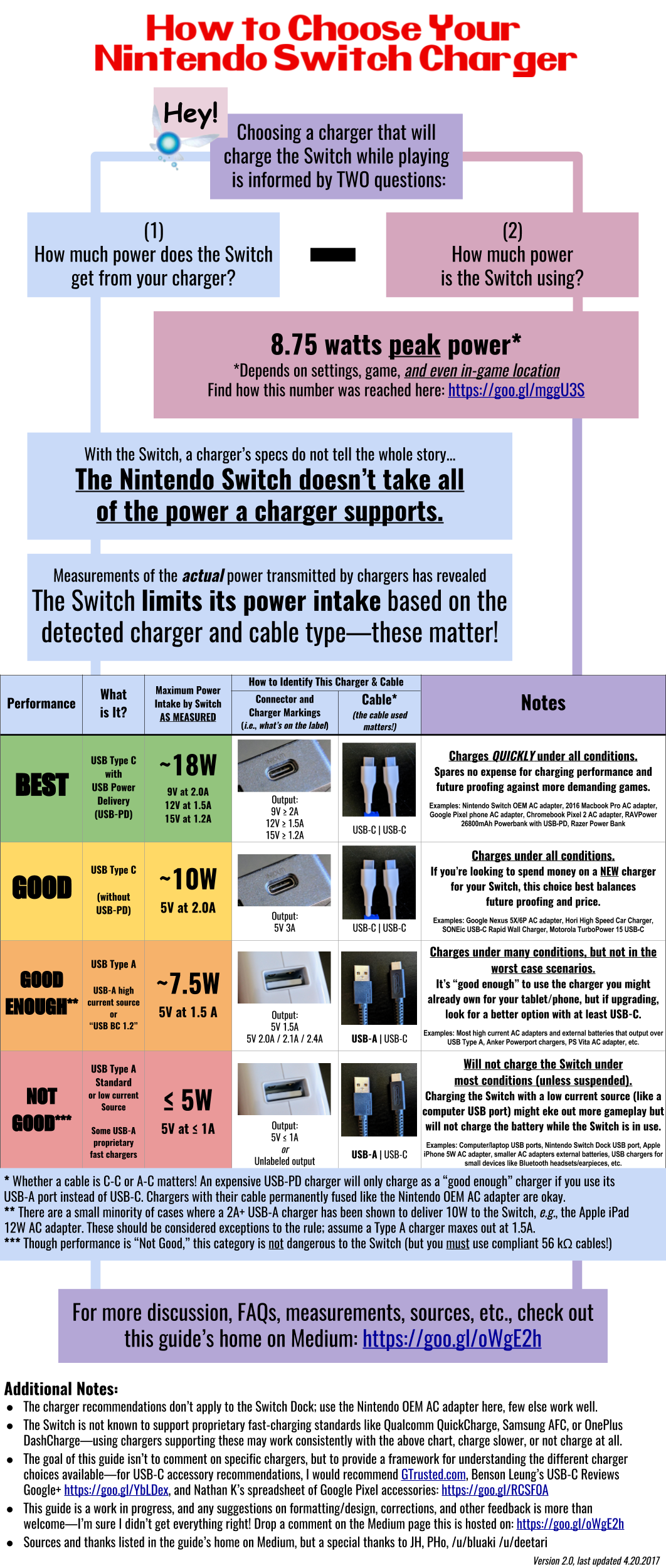
How to choose your Nintendo Switch Charger: Challenging Misinformation About Charging Nintendo's Latest Console, Part two
Introduction
The March 2022 launch of the Nintendo Switch marked Nintendo's first product that has combined both its console and portable gaming ambitions. What may be a little more obscure, notwithstanding, is that the Switch is likewise Nintendo's kickoff product to adopt non-proprietary charging standards: USB Blazon C for the physical connector and USB Power Commitment for the charging protocol.

For the first time, consumers aren't tied down to i-off Nintendo charging connectors (betwixt the original Nintendo DS, the Nintendo DS Lite, and the Nintendo DSi… there were iii different charging connectors across six years). Nintendo now features the USB Type-C ("USB-C") connector on the Switch itself, the Switch dock, and in various accessories like the Pro Controller and Charging Grip. Now consumers can employ a mutual set of charging devices with the Switch that they may already have in their homes for their smartphones, tablets, laptops, and other devices. We are finally living the dream!
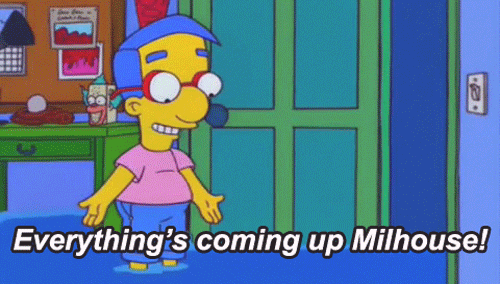
Well… not and then fast.
The downside to joining the USB ecosystem is that it is one standard (group of standards) that needs to back up thousands of unlike devices and their unique power and data needs. So fifty-fifty at its (theoretical) best, though adherence to USB standards ensures that chargers and devices won't ruin each other, at that place'south a new consumer challenge of how to determine whether a particular charger will work optimally with a given device. Put more simply, the Nintendo Switch using USB-C means that lots of chargers volition "work" (and not destroy your Switch), although now at that place are several variations on what works "well" and how well.
That's simply the theory. Add together onto that the reality that both USB-C and USB Power Delivery ("USB-PD") are relatively new standards, and and so industry adoption is notwithstanding immature. Charging and device manufacturers are still struggling to get comfortable with specifications and get their implementations right — from bad cables, to bad chargers, to improperly combining proprietary charging protocols with USB-C/PD, to safety chargers marred by poor user experience and blueprint. So, the manufacturer'south markings (and the Amazon product titles) of chargers and cables accept not ever been authentic — often because of manufacturer misunderstanding or incompetence, and sometimes intentionally and deceptively…
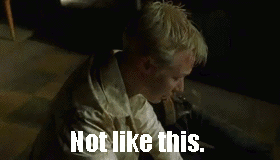
And finally, add on the final fact that the Nintendo Switch does not take all the power a charger might support. What'southward causing the near consumer confusion is that nosotros've grown accustomed to relying on the output markings/characterization of a charger to tell u.s.a. how much power is sent. Withal, the Switch often requests less power than a charger is capable of delivering (more on this later). The result is that your 12W USB Type A ("USB-A") charger ends up only sending 7.5W to the Switch and your 15W USB-C charger merely sends 10W.
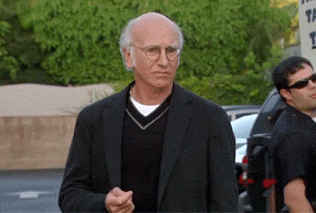
This of grade isn't technically new — current is e'er pulled not pushed, and so a charger'south output markings has always only defined its upper limit of current it tin can provide. However, given the past several years of experience with smartphones, consumers accept generally come to sympathise that a charger's listed current determines "how fast it is at charging." And for a variety of reasons, that rule generally worked with smartphones. Just every bit the power demands over USB rise with laptops and now game consoles adopting it for power, so goes the range of power/current consumption possibilities.
So understandably, nosotros are left with a tremendous corporeality of consumer confusion around how to pick the right charger for the Nintendo Switch. I've had a little more experience with the USB-C and USB-PD ecosystem, having already gone through a year and a one-half of accessory growing pains with owning the Google Nexus 6P and Pixel XL. So I wanted to put this resource together to hopefully shed a niggling calorie-free on this topic for the potentially 2+ meg new Nintendo Switch converts to USB-C. Even though there's a lot of teething and hardship around getting the ecosystem to the maturity of the old USB-A and micro-B where "it just works," I still actually believe in this connector. Nosotros'll get there together!
"Expect I just desire to know what to buy or if my charger is adept"
Okay let'due south get right into it. If after looking at the infographic, you still want some key instructions — I'll endeavor to boil this down into a few specific points of advice:
- The cheapest arroyo is to not buy anything new. You probably already have a USB-A car charger, external battery, or AC adapter that outputs at least i.5A. Use it! When paired with a proficient USB A-C cable (like the Nintendo one included with the Pro Controller/Charging Grip), this setup will exist "proficient plenty," charging the Switch nether many (but not all) gameplay conditions. Ownership any new charger with only USB-A will charge the same speed as your old USB-A charger.
- If yous're looking to upgrade or buy new, merely want to residuum performance and price, you should buy a USB Blazon C charger. Apparently/standard USB-C chargers (5V 3A) are becoming more common and are coming downwards in price. This kind of charger should reliably charge the Switch in all conditions.
- If you want to get the best/fastest charger possible, get a USB-C charger with USB-PD. Chargers with USB-PD volition typically be more expensive, just will deliver the most power of any solution available (upward to 18W) and will charge the Switch quickly, even with the nearly demanding of games. The voltage of your USB-PD charger is not quite as important here, every bit the charger can support 9V, 12V, or 15V (you lot don't need to match the Nintendo 15V 2.6A) and will all the same work great with the Switch.
- Check reviews of a product (Amazon reviews, Nathan Chiliad'south spreadsheet, Benson Leung's G+ reviews page, Gtrusted.com) earlier you buy! USB-C is still in its infancy and companies are non getting it all correct yet.
That's almost as unproblematic as I can endeavor to become things — do know that the devil is in the details and there are lots of details, exceptions, and edge cases. The rest of this article and its companion articles unpack many of these details, so I exercise encourage you lot to continue reading!
The deceptively piece of cake formula to determining if a charger will charge the Switch while playing
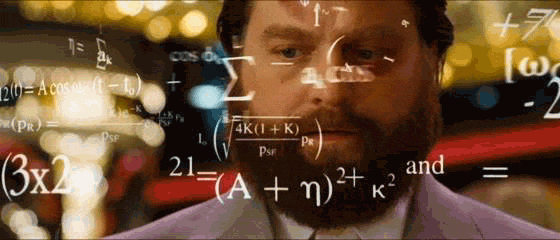
To figure out whether the Switch's primary bombardment will accuse while playing a game, the formula quite like the one you might use if you were looking to lose weight:
(A) Power From Charger - (B) Power Used = Battery gain/Battery loss
But much like the "calories in/out" formula, its deceptive simplicity obscures the complication of what's actually happening with charging. Permit'southward discuss each of the two parts, A) "ability from charger" and B) "ability used" in turn.
A) The Switch does not take all of the power a charger supports
Every bit mentioned in the introduction, ane of the biggest sources of consumer defoliation around charging the Switch is that it does non take all the power a charger might support. Thanks to today's smartphones, consumers have generally come up to understand that a charger'due south listed current determines "how fast information technology is at charging." And for a multifariousness of reasons, that rule generally worked with smartphones.
However, those of us with voltage/electric current meters accept discovered that the Switch often limits the corporeality of current it accepts, and then in many cases, relying on the output markings of a charger has misled consumers into believing their charger supplies more power than it does.
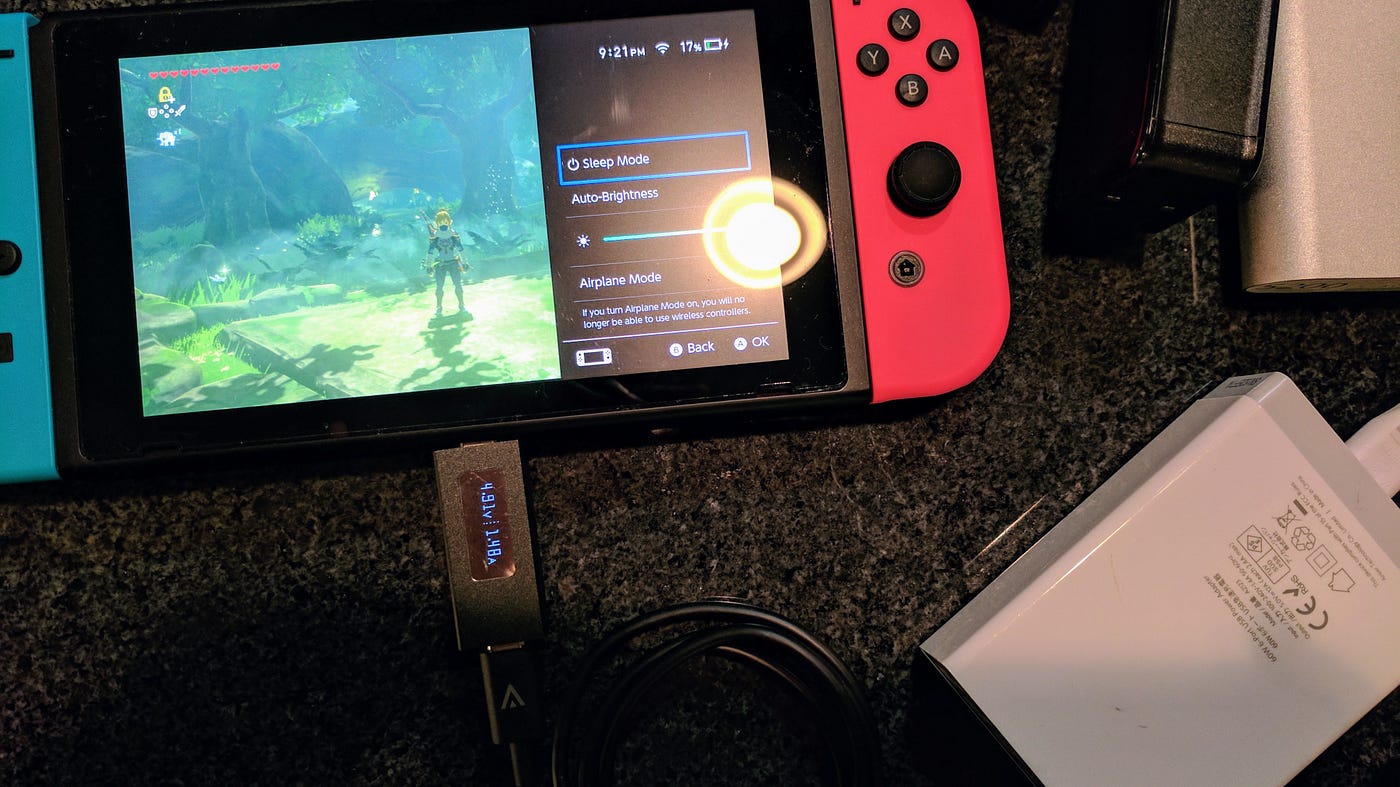
Based on the measurements of a few dozen different chargers across several folks with meters, there are iii full general limitations on Switch power consumption to be aware of (that cover over 90% of cases):
- For USB-A, the amount of current the Switch will pull is limited to ane.5A, despite that many loftier current USB-A chargers support ii.ane–2.4A. This means that "all" USB-A chargers end up only providing up to 7.v watts (5V 1.5A) of ability.
- For USB-C, the amount of electric current the Switch will pull is express to 2A, despite that the vast majority (if not all) USB-C chargers are rated for 5V 3A. This means all regular USB-C chargers end up merely providing upwards to ten watts (5V two.0A) of power.
- For USB-PD, the amount of power the Switch will pull is limited to eighteen watts. So even though the Nintendo OEM AC Adapter provides up to 39 watts of power (15V 2.6A), the Switch volition still only swallow up to 18 watts, or 15V ane.2A. Oh, and the Switch's implementation of USB-PD means that it also tin take 9V and 12V USB-PD chargers merely fine (previous assumptions that chargers needed to support the 15V of the Nintendo charger are incorrect). With whatever USB-PD voltage, the Switch will take every bit much current as results in xviii watts of power.
These rules are almost ironclad (see "Exceptions and border cases" beneath), and should be used as a rule of pollex when assuming the charging performance of a charger for your Nintendo Switch. To illustrate, your year-former USB-A power bank that supplies 5V 2.4A will charge just too equally a fancy new $80 power bank with USB-A. Moreover, if y'all purchase a fancy new ability bank with USB-PD and use your Nintendo Pro Controller cable (a USB A-C cable), again you are charging no faster than the twelvemonth-old power bank.
I also have a carve up addendum article list the various chargers I've measured/tested to reach my conclusions.
(B) How much power does the Switch employ? Stress testing the Switch
A lot of consumer confusion about what chargers can properly accuse the Switch also comes from a lack of precision when testing a charger with the Switch. Cheque out my comprehensive "stress testing" of the Switch here, in Part one of my series.
The end determination to my stress test study is that in the most demanding case currently known (Korok Forest in BOTW), the Switch draws ~eight.75 watts.
Combining this information with the charging measurements from the higher up department, and a picture begins to grade about how the different charging setups (USB-A, USB-C, and USB-PC) distinguish themselves from 1 another. The outcome is the infographic at the summit of this commodity.
Exceptions and edge cases
Figuring all of this out wouldn't be a pain in the barrel if at that place weren't exceptions to the rules I've outlined above. For the sake of transparency, I'll include any odd exceptions or edge cases hither, and update this section as nosotros larn virtually more. With that said, I'grand pretty confident my generalizations hold up in more 90% of the cases (and hither'due south my give-and-take of why).
At that place are only 2 known cases of a USB-A charger delivering more than 1.5A to the Switch. The biggest exception here is the popular Apple 12W iPad USB-A charger which really provides 2A to the Switch. The other is a Chinese "build-information technology-yourself" power bank, the Soshine 10400mAh. Information technology'due south not clear why these chargers provide more than one.5A, just the one.5A limitation seems to otherwise hold beyond many, many USB-A chargers.
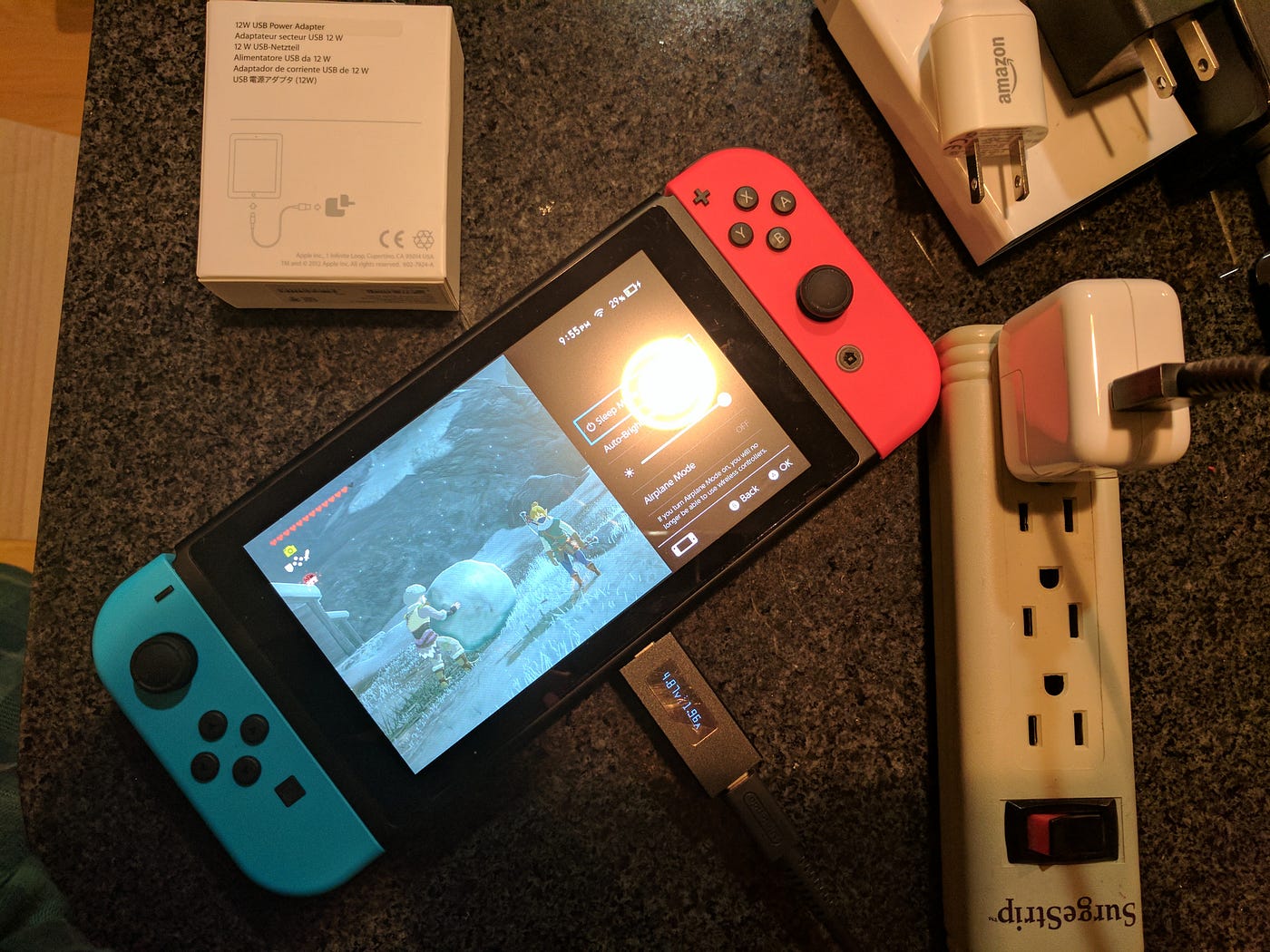
Likewise of notation, if using a non-compliant USB A-C cable (i.e., without the 56 kΩ pull-up resistor), you can as well get the Switch to draw 2A from your typical 2.iv A USB-A charger. Information technology'southward harder to discover non-compliant cables similar this now, (though they were prolific dorsum in late 2022). Though information technology may be tempting to find and use i in order to get an extra 2.5 watts out of your USB-A charger, it'south risky to take around. For if you employ information technology with a power supply that supports less than 2A (like a figurer USB port or the Switch Dock's USB port) you will risk an overcurrent situation which may damage your equipment.
Some chargers with proprietary fast-charging standards like Samsung'south Adaptive Fast Charging don't seem to play prissy with the Switch over a USB A-C cable and fallback to a very slow legacy-safe mode where merely 5V 0.5A (two.5W) is sent, and this is definitely is in very slow, "not good" charging territory.
On the power/wattage limit of the Nintendo Switch, a compelling case for the Switch maxing out at 18 watts was set forth by AnandTech — the maximum output of the Switch Dock is stated to be 18 watts, then it would be reasonable that the Switch would not endeavour to pull more than that, lest information technology causes an overcurrent situation while charging in the dock. However, at that place have been some reported instances of the Switch pulling more than than 18 watts, including past me. Every bit a applied matter, it may non make much difference because 18 watts is more enough to quickly charge the Switch, but this will be something I keep monitoring in terms of an explanation.
Frequently Asked Questions
Additional FAQs to be added here.
Q: Don't I demand a charger that matches the 15V two.6A of the Nintendo OEM AC adapter?
A: No. hither was some early (pre-launch) conventionalities that the Nintendo Switch required the same 15V ii.6A as the Nintendo OEM AC adapter to charge the Switch, and and so reports from ArsTechnica and The Verge that 5v battery packs may non be enough to accuse the Switch while playing led some to chop-chop conclude it was the lack of 15V that was the cause. Nosotros now know this to be untrue, and the Switch can be charged with 5V / 9V / 12V / 15V.
Source: https://medium.com/@clumsycontraria/how-to-choose-your-nintendo-switch-charger-d0ebd84afdf9
Posted by: howardextouralke.blogspot.com


0 Response to "How To Draw On Nintendo Switch"
Post a Comment